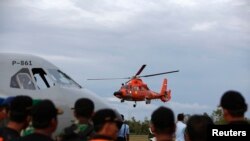Two more bodies were recovered Thursday from the Java Sea, as bad weather once again slowed the search for a crashed AirAsia jet.
One Indonesian official also warned it could take at least a week before the plane is located.
Authorities had been hopeful a break in the weather early Thursday would speed up the search. But by the afternoon, another rush of heavy rains and wind grounded helicopters searching for bodies and wreckage.
So far nine bodies and debris, a suitcase, an emergency slide and a lifejacket, have been pulled from the Java Sea near Borneo Island, where the Airbus A320 carrying 162 passengers and crew crashed on Sunday.
One of the bodies is that of a female flight attendant, who was found in her uniform, according to East Java disaster official Budiyono Mars.
At a news conference Thursday in Jakarta, Fransiskus Bambang Soelistyo, head of Indonesia's National Search and Rescue agency, confirmed the number of bodies recovered.
"Six bodies have already been transferred to Surabaya. Two bodies are still in Pangkalan Bun and the other one is still on the ship, Yos Sudarso."
Indonesia’s chief forensic police officer, Anton Castilani, said formal identification was transferred from central Kalimantan’s Pangkalan Bun to Surabaya, where relatives of the victims are waiting.
Victim named
Budiyono Mars also said the identity of the first body recovered, that of a female passenger, was now confirmed.
"The body with the label 001 has been identified as Hayati Lutfiah Hamid," he said.
Her body, in a dark casket topped with flowers, was handed over to family members during a brief ceremony at a police hospital in Surabaya, the Indonesian city where the plane took off.
The coffin was then taken to a village and lowered into a muddy grave, following Muslim obligations requiring bodies to be buried quickly. Three other members of her family aboard the flight have yet to be found.
Black box
Indonesian air safety investigator Toos Sanitiyoso said the main priority now is locating the main crash site, but warned it could take at least a week before the black box, containing the flight data and cockpit voice recorders, is found.
France's crash investigation agency (BEA) said its specialist black box search team and equipment would arrive early Friday at the search area.
"During the morning of January 2 local time, a ship will be taking the investigators to the search area, with detection equipment including hydrophones, in order to try to locate the acoustic beacons from the two flight recorders,'' the agency said in a statement.
It assists in the investigation of any air crash involving Airbus aircraft because the company is France-based.
Officials are waiting to comb an area where aerial searches on Wednesday spotted what appeared to be a large shadow in a relatively shallow section of the sea. Once conditions improve, a team of 47 Indonesian divers is on standby to investigate the site. But officials have stressed they do not know if the shadow is the main body of the plane, as some have speculated.
Searches on Thursday spanned an area of 13,500 square kilometers (5,200 square miles) involving 19 ships, four helicopters and five planes, Soelistyo said.
Before takeoff and during the last moments of the flight, the pilots requested to fly at a higher altitude to avoid a storm cloud. The request was not approved because other planes were in the area.
The twin-engine jet disappeared from radar, without a distress call, about a half-hour into what was supposed to be a two-hour flight from Surabaya to Singapore.
Possible causes
Regional analysts have said one possible reason behind the crash was due to pilot error in venturing near the heavy monsoon storm. A request by the experienced Indonesian pilot to fly at a higher altitude to avoid the weather was delayed, with ground control losing communication with the aircraft soon after.
Some experts think the plane may have experienced icing at 35,000 feet affecting its capacity to fly, buffeted by powerful up drafts of air, and may have been ascending at too slow a speed for such a large aircraft.
Asia’s aviation industry has experienced strong growth over the past decade, especially since the entry of the low-cost carrier into the market. T
The International Air Transport Association said Asia Pacific accounts for more than 30 percent of global passenger traffic. This is set to rise to over 40 percent within 20 years.
The rapid growth has raised fears over risk management in Indonesia and across the Asia Pacific, said Hugh Ritchie, chief executive of Sydney-based Aviation Consultants International.
Air safety a concern
Ritchie said a full investigation needs to be carried out to improve regional air safety standards. A recent report found Indonesia’s air safety record was still well below the global average.
“With this growth in aviation - and it’s a manic growth - it’s an uncontrolled growth and the regulators cannot keep up with it. They cannot keep up with the oversight," he said. "[Standards] need to be raised, they need to be enforced and there has to be a detailed training process, not just for the airline management and senior personnel, but for the regulators."
The tragedy is the first for AirAsia, a low-cost carrier that has been operating since 2002 and is a leader in the growing market, with more than 170 aircraft in the region.
The head of the airline, Malaysian businessman Tony Fernandes, has maintained a high profile during the crisis, meeting with victims’ families, and AirAsia has provided regular updates on the search and recovery.
Ron Corben contributed to this article from Bangkok. Some material was provided by Reuters and AP.




